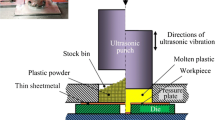Abstract
This paper aims to propose the design of a new polishing tool, a clamp with a flexible polishing head (or CFPH) for polishing plastic mold steel. The investigation/evaluation of this new tool’s performance in polishing is also included in this paper. The design of this brand new flexible clamp with a polishing head is, first of all, based on the application of the concept of weakening gap in the study of Fuh [1] increase in the freedom of micro-movement of the clamp is available. Second, various analyses and tests are done by the finite element method (FEM). Then, through the spectrogram, we analyze this tool’s machining characteristics. Furthermore, by the performance on large waves, medium waves, and small waves of the workpiece, we evaluate the working efficiency and set up a set of polishing strategies. This module of machining strategy process contains the combination of cutting and polishing one kind or multi-kind machining modes and the complementary precision processing methods. Finally, we propose a set of polishing integration process skills specifically on S-STAR*. We also verify our analysis with 3D profiles and the surface roughness measurement instrument. These verified analyses show that roughness and shape precision can be reached to Ra0.006, Rmax0.08, and PV0.084 μm respectively. This new invention, by the spectrum analysis, can significantly improve large wavelength accuracy up to 83.9 %, medium wavelength accuracy 82.5 %, and small wavelength accuracy 80.2 %. To conclude, we aim to set up a mirror-like surface polishing tool for plastic mold steel. This proposal is prudentially verified and should be considered theoretically and practically successful.
Similar content being viewed by others
References
Fuh K-H (1986) The cutting tools. Gau-Lih Books Co., Ltd., Taipei, pp 165–167
Jones RA (1978) Fabrication using the computer controlled polishing. Appl Opt 17(12):1889–1892
Jones RA (1995) Computer simulation of smoothing during computer-controlled optical polishing. Appl Opt 34(7):1162–1169
Wang S-Y, Su Y-T (1997) An investigation on machinability of different materials by hydrodynamic polishing process. Wear 211(2):185–191
Tsai M-J, Huang J-F (2006) Efficient automatic polishing process with a new compliant abrasive tool. Int J Adv Manuf Technol 30(9–10):817–827
Han H, Libo Z, Ling Y (2011) Polishing using flexible abrasive tools and loose abrasives. Machining with abrasives., pp 345–384
Schotborgh WO, Kokkeler Frans GM, Hans T, van Houten FJAM (2005) Dimensionless design graphs for flexure elements and a comparison between three flexure elements. Precis Eng 29(1):41–47
Su Y-T, Kao Y-C (1999) An experimental study on machining rate distribution of hydrodynamic polishing process. Wear 224(1):95–105
Su Y-T, Horng C-C, Hwang Y-D, Guo W-K (1996) Effect of tool surface irregularities on machining rate of a hydrodynamic polishing process. Wear 199(1):89–99
Huang H-Y, Fuh K-H, Wu J-S (2010) Analysis of a tool system with a four axes flexible fixture. Adv Mater Res 154-155:1348–1355
Shilong Z, Fasse Emest D (1998) A finite-element-based method to determine the spatial stiffness properties of a notch hinge. J Mech Des 123(1):141–147
Elfizy AT, Bone GM, Elbestawi MA (2005) Design and control of a dual-stage feed drive. Int J Mach Tools Manuf 45(2):153–165
Smith ST, Badami VG, Dale JS, Ying X (1997) Elliptical flexure hinges. Rev Sci Instrum 68(3):1474–1483
Logan DL (2007) A first course in the finite element method, 4th edn. Thomson, Kentucky
Hwang W-S, Park HC (1993) Finite element modeling of piezoelectric sensors and actuators. AIAA J 31(5):930–937
Yeh W-C, Chu T-S, Wang S-S, Fuh K-H, Chen K-H (2011) Finite element analysis of blanking process by superimposing ultrasonic vibrations. Adv Mater Res 201–203:126–132
Toshimichi M, Eiji S, Song Y-C, Seido K (2004) Development of a elliptical vibration milling machine. Ann CIRP Manuf Technol 53(1):341–344
Kim J-D, Choi I-H (1997) Micro surface phenomenon of ductile cutting in the ultrasonic vibration cutting of optical plastics. J Mater Process Technol 68(1):89–98
Author information
Authors and Affiliations
Corresponding authors
Additional information
The S-STAR* is a special kind of plastic model steel from the company DAIDO, Japan.
Rights and permissions
About this article
Cite this article
Huang, HY., Fuh, KH., Wu, JS. et al. A new integrated polishing process design for plastic mold steel to mirror-like surface. Int J Adv Manuf Technol 73, 1633–1645 (2014). https://doi.org/10.1007/s00170-014-5855-y
Received:
Accepted:
Published:
Issue Date:
DOI: https://doi.org/10.1007/s00170-014-5855-y




